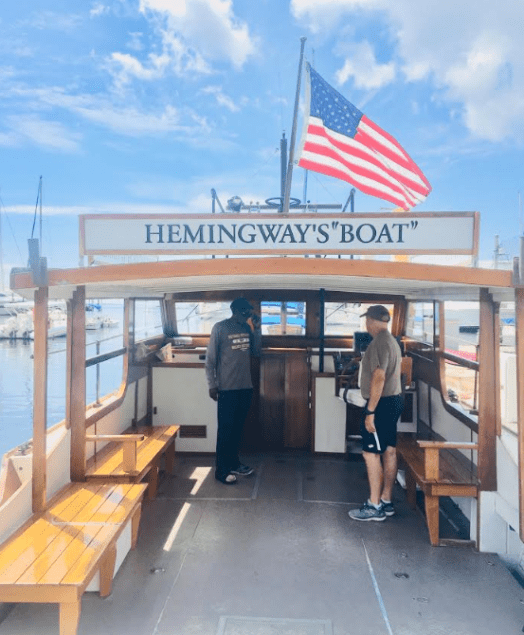How do you Shake-A-Leg when both clock out for the last time as a teenager after flying off a pick-up truck in your Rhode Island hometown of Newport? Yes, S-A-L’s founder, Harry Horgan, did all that…
By: Word of Mouth.
That’s how Mayor Xavier Suarez caught wind of Harry’s success getting people with similar disabilities out on our nation’s northeastern seas back in the 1980s. And permitted him to zone his magic here, land-use puns intended, right off South Bayshore Drive in 1990.
Morning Crew
White picket fencing marks the spot under the WELCOME TO SHAKE-A-LEG MIAMI! banner on a sunny Coconut Grove Saturday morning. White tenting adjoins the historic seaplane hangar with large U.S. COAST GUARD lettering. Monty’s Bar faces out from the parking lot.
The hangar stores S-A-L’s fleet of Freedom 20 skiffs, paddle boards, life jackets, kayaks, motorcycles, gym equipment, and more. Flag banners hang championship-style from the rafters for each U.S. armed forces division.
As Chris Pearson- deployed with the Army’s airborne civil affairs unit in the 1990’s to Venezuela, Panama, and Honduras building hospitals, resurfacing roads, and training armies- tells it, this was Coast Guard headquarters for fifty years before moves to Watson Island and Opa-Locka.
Raised in Miami and a father of two teenagers, Chris points to a green heron nearby. He tells me how our nation’s submarines whisked off from here to rescue people on ships sunk by Nazis during World War II. And how our Navy trained here on Dinner Key.
Carlos Gonzalez joins our conversation at the outdoor tables in the shade by the cool-colored, Murano- style mural next to the art room where veterans hone their inner Bob Ross. Build boats. And more.
He left Cuba in 1961, two days after turning fifteen as part of Operation Pedro Pan’s resettlement of unaccompanied minors into U.S. refugee camps. Today, he’s decked out in a white t-shirt with bold blue lettering commemorating S-A-L’s participation in the Columbus Day regatta.
Back as a teenager, Carlos first arrived to Oregon. Then he deployed downrange in Vietnam and Desert Storm. And now, retired from the military, with boat captain’s licensing from the Coast Guard’s six-week certification course, makes it here to teach similarly situated veterans with disabilities.
“Push yourself to the limit rather than being limited,” he notes with steady cadence. His daughter worked for Sean Hannity and lives in Belgium. Vacation with wife and grandkids is up next.
Community Collaborations & Plans Ahead
It seems there isn’t a group S-A-L hasn’t partnered up with. From physical therapists and communications and journalism professors and students at UM and FIU to various veterans’ groups, it’s the grassroots part that Harry harks on even more than the VA grant funding tied to the programming.
We check out S-A-L’s replica of Ernest Hemingway’s black, white, and brown fishing boat with wood finishing named Pilar. And Harry tells me about preliminary talks he’s having with History Miami’s executive director, Jorge Zamanillo, to build exhibits on-site at S-A-L.
The centerpiece of these exhibits will arguably be the 1940 PT boat. It’s currently in Louisiana. And will take four days to get here, depending on the weather, Harry explains. The plan, he goes on, is to restore it. It’ll be wheelchair accessible after manhours from veterans’ nonprofit The Mission Continues and from boat repair shop Apex Marine on the Miami River. “The carpenters and mechanics are magicians,” Carlos says, recalling their handiwork after Hurricane Irma a few years ago.
Mike Jones of Royal Caribbean Cruises is helping with logistics. And Mayor Carlos Gimenez is on board. If all goes as planned, the PT boat and Guard museums open to the public by summer 2020.
Miracles on Aviation Avenue
Veteran Donoray Bickham, sporting a gray, long-sleeved National Veterans 2018 Golden Age Games shirt with gold lettering from his participation in New Mexico, laughs like Larry David. “You have two on the court so you don’t have to be quick,” he explains in playing down the pickleball and other events for the veterans over 55 who join.
He recounts the age groups: “55-59; 60-64; 65-69,” and tells us about a 93-year-old with whom he played fifteen games of checkers who medaled multiple times; without missing a beat, Harry dryly responds that of course the 93-year-old medaled, he didn’t have any competitors in his age group.
Donoray was legally blind. He read somewhere that pilot’s visual acuity increases twenty percent after spending more time in a cockpit. This is how he makes sense of his own vision coming back. The first time he went out on the water was in 2009 with Shake-A-Leg Miami. Three years later the cues of being out in the elements apparently did their thing.
No less miraculous is a veteran named Sharmaine, who went from a self-described “nice home and master’s degree” to homelessness and forty years of PTSD. But after much encouragement from a friend at Unity on the Bay’s nondenominational services at Temple Israel. And the help today of her spotted white service dog, identified on its U.S. flag-draped and color photo tag as Lady Thomas, Sharmaine made it.
Dedication
Thank you to everyone who connects in any way to Shake-A-Leg Miami. As Harry says, it’s about creating “an environment to make people more resilient and inspired.” This article is dedicated to my friend, Paul Irgang, who served in the Vietnam War. Paul and his wife, Janet, are the heart of the University of Miami Wellness Center Pool on weekends. Janet gets seasick just thinking of boats. And Paul isn’t a fan of August heat in Miami. But here’s to Paul being inspired as he listens to this article being read by his Davinci text-to-speech reader, to join us out on the water one of these days. And to everyone out there who could use some quiet time out on the bay with new friends.
For more information on planning your visit, please go to shakealegmiami.org.







Comments are closed.